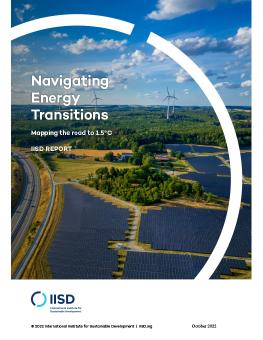
Navigating Energy Transitions: Mapping the road to 1.5°C
This report highlights the implications of 1.5°C scenarios for the phase-out of fossil fuels and the scale-up to renewables, barriers to transitions and solutions to such challenges, and tools for governments and financial institutions to navigate the current energy crisis while maintaining climate ambition. It also looks at the implications of the war in Ukraine for energy systems and explores whether Europe can meet its gas demand without the Russian supply.
-
Global oil and gas production must decrease by at least 65% by 2050 according to a consensus of selected 1.5°C-compatible energy scenarios. Developing any new oil and gas fields would prevent the world from limiting global warming to 1.5°C or create stranded assets.
-
Planned investments for new oil and gas to 2030 could fully finance the scale-up of wind and solar energy needed to limit global warming to 1.5°C.
-
Europe's existing gas import capacities are sufficient to meet the continent's 1.5°C-compatible energy demand from 2024 onward. Europe can and must meet its energy needs without the Russian gas supply as of 2024 to limit global warming to 1.5°C.
The world must set itself on a pathway consistent with limiting global warming to 1.5°C to avoid the most disruptive and tragic consequences of climate change on people, ecosystems, and economies. This is extremely urgent and every fraction of a degree matters: at present rates of greenhouse gas (GHG) emissions, the world’s remaining carbon budget will be extinguished in approximately 8 years. The world can still achieve the 1.5°C goal, but the window to do so is narrowing quickly. Governments must urgently exceed the ambition of their current Paris Agreement pledges.
This report provides the first-ever comparison of large numbers of climate and energy pathways from various institutions to outline what is needed to limit global warming to 1.5°C. It provides an assessment of the energy policies required to align with scenarios reviewed by the IPCC Sixth Assessment Report, those produced by intergovernmental organizations such as the International Energy Agency (IEA) and the International Renewable Energy Agency (IRENA), and by prominent scenarios designed by private sector consultancies.
The report finds a high degree of alignment between scenarios, and draws key conclusions on:
- The required phase-out pathways for oil and gas production between now and 2050, at the global level.
- The required levels of solar and wind energy deployment to substitute fossil energy production, at both global and regional levels.
- The investment gaps between current and planned spending and the investment needed to achieve Paris-aligned investment pathways, both globally and regionally.
Moreover, the report outlines the expected impacts of the war in Ukraine on renewable energy, addresses the role of the private sector in the energy transition, and recommends a number of actions that governments, investors, and financial institutions can take in order to align with 1.5°C scenarios.
You might also be interested in
Budgeting for Net Zero
This study estimates the cost gap for battery energy storage systems (BESSs), offshore wind, solar photovoltaic (PV), electric vehicles (EVs), and green hydrogen (GH2) to inform government support.
March 2025 | Carbon Minefields Oil and Gas Exploration Monitor
Last month, a total of 22 oil and gas exploration licences were awarded across six countries, with an estimated volume of discovered resources of 45.4 million barrels of oil and 10.4 billion cubic feet of gas.
Getting Where We Need to Go: Net-zero transport in Canada
This brief explains how a clean passenger transport system based on walking, cycling, public transit and electric vehicles can reduce costs for households and reliably meet Canadians' transportation needs while making cities cleaner, quieter, and safer.
How Indigenous Negotiators Fared in 2024
In the foreword in The State of Global Environmental Governance 2024, Hindou Oumarou Ibrahim shares her insights on what goals were reached, where "business as usual" must change, and what her priorities are for 2025.